Lower Animals, Invertebrates
Background Information:
Kingdom Animalia
includes about 35 phyla. When many people think of animals, they only think
of
mammals,
yet Class Mammalia is only one class in Subphylum Vertebrata, which is only
one subphylum within Phylum Chordata. We tend to lump all the other phyla
and other taxa within Vertebrata into a catch-all pseudo-group, the
“invertebrates,” but this is about 95% of all animals! There are more
species of insects than all other plants and animals together (The more
conservative estimates are that there are over one million species of just
insects.). Mammals are only a minuscule piece of the picture.
Animals live practically everywhere on this Earth. Insects,
alone, inhabit nearly all possible environments on Earth with the exception
of deep in the ocean, yet their close relatives, the crustaceans have
representatives that live there. Many other animals in many phyla live in
the ocean and in just about every terrestrial habitat.
In general, animal reproduction includes flagellated
sperm and a larger egg which join in fertilization to
form a
zygote.
This grows by
mitosis
to form a blastula (blasto = bud, sprout), an embryonic stage
that resembles a hollow ball, then on to other embryonic stages. From this
point, if the young resemble the adults, it is said that the embryo
grows into young, which grow into adults. If the young are very different
from the adults, it is said that the embryo grows into a larva
(larva = ghost, specter) which grows and metamorphoses into an
adult. Caterpillars and tadpoles are larvae, which have different
food, habitat, and appearance than the corresponding adults. A larva
undergoes metamorphosis (meta = between, with, change;
morpho = form; -sis = the act of) to become an adult.

Body Symmetry and Layers
Before discussing the various animal phyla, it is useful to introduce some of
the terminology which will be used to describe these animals. The back or
top side of an animal is its dorsal (dorso = back) side, and
its belly or bottom side is its ventral (vent(er) = underside,
belly) side. The head or front end is called the anterior (ante
= before) end, and the tail or back end is the posterior (post
= behind, after). Animals with radial symmetry (radia = spoke,
radius; sym = with, together, metr, -metry = measure,
measurement) do have distinct top and bottom sides, but have no distinct
left and right.
Starfish, jellyfish, and sea anemones are examples of animals with radial
symmetry. Animals with bilateral symmetry (bi = two;
later = side) do have distinct left and right sides, and most animals
with which we are familiar, such as earthworms, ladybugs, and dogs, have
bilateral symmetry.
The body of an animal is made up of several layers of tissue.
Ectoderm (ecto = out, outer, outside; derm = skin) is
the outer layer of tissue. The epidermis (epi = upon, over),
or skin, other outer layers, and the nervous system in vertebrates (not in
all animals) are formed from ectoderm tissue. Mesoderm (meso
= middle) is the middle layers of tissue. Mesoderm forms the muscles and
most other internal organs. Endoderm (endo = within, inner)
forms the inner layers, including the lining of the digestive tract in all
animals and the liver and lungs in vertebrates. Often animals have a space
in their bodies between several of these layers.
Animal groups, like flatworms, with no such space are referred to as
acoelomates. Animals, such as roundworms, which have a space
between the mesoderm and the endoderm are called pseudocoelomates,
and the space is called a pseudocoelom. Animals, including earthworms,
insects, and humans, which have the space in between several of the mesoderm
layers are called coelomates, and the space is called a
coelom.
Animal Phyla
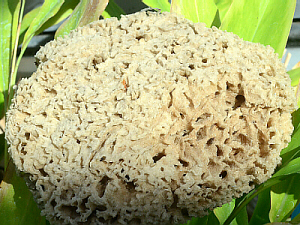
Sea or Commercial Sponge
- Phylum Porifera
- (pori = pore; fer = bear, carry)
These are the sponges. As adults, they are sessile (attached to one
place), but have free-swimming larvae. Sponges are
hermaphroditic,
that is, they have both sexes in one body.
This term is derived from the myth in which Hermes (Mercury) and
Aphrodite (Venus) got together and had a son, who they named
Hermaphroditus, who while swimming one day, somehow became united in
one body with a water nymph. Sponges have no symmetry.
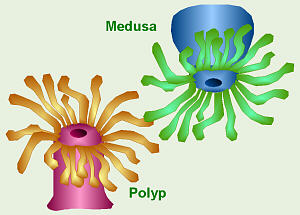
Polyp and Medusa Forms

Live Hydra
- Phylum Cnidaria or Coelenterata
- (cnida = a nettle)
This includes animals like jellyfish (Class Scyphozoa), coral
and sea anemones (Class Anthozoa [anthe = flower;
zoa = animal]), all of which are marine, plus Hydra, a
freshwater genus (Class Hydrozoa). These animals have radial
symmetry. They have a digestive cavity with one opening, which thus
is called a gastrovascular cavity (gastro = stomach;
vascul = a little vessel). The one opening serves as both a
mouth to ingest food and for expulsion of any wastes.
The bodies of cnidarians are described in one of two ways, depending
on whether the opening of the gastrovascular cavity is ventral or
dorsal. Animals like Hydra and sea anemones, which are sessile
and have the opening and surrounding tentacles at the top of their
bodies have a body shape called a polyp (polyp = many
footed). Jellyfish, which float and have the opening and surrounding
tentacles at the bottom, have a body form called a medusa
(medusa = a jellyfish). Cnidarian tentacles serve to capture
prey. These tentacles bear stinging cells, called cnidocytes,
to subdue their prey, and some jellyfish cnidocytes irritating or
toxic to humans. Cnidarians have both sexual and asexual forms of
reproduction. Hydra, for example, will periodically develop
lumps on the sides of their bodies that are either testes or ovaries.
These make and release sperm or eggs, which then join to form a zygote,
which eventually grows into a new hydra. Hydra also reproduce
asexually by a process known as budding in which a new, small
Hydra begins to grow from the side of a large Hydra,
eventually pinching off when it is fully formed.
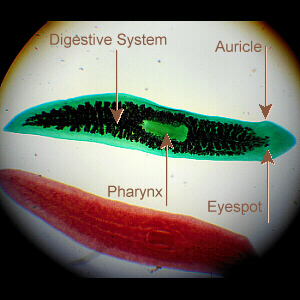
Labeled, Prepared Slide of Planarian
- Phylum Platyhelminthes
- (platy = broad, flat; helminth = a worm)
These are the flatworms because their bodies are flat and ribbonlike.
They have bilateral symmetry, but are acoelomates. They have a
gastrovascular cavity with one opening. Most have no respiratory
structures and “breathe” through their skin.
The free-living (water-dwelling) ones include planaria (Class
Turbellaria). Planaria have eyespots to detect light. Some
interesting experiments have been done to study their learning ability.
They are hermaphroditic and reproduce sexually. They are also capable of
asexual reproduction, and many experiments have been done to study the
ability of cut planarians to regenerate new planaria or parts of
planaria.
Parasitic flatworms include flukes (Class Trematoda),
which have complex life cycles needing specific hosts. Genus
Schistosoma is a parasite whose life cycle involves both
humans and snails, hence the caution not to wade in water in tropical
areas where this fluke occurs.
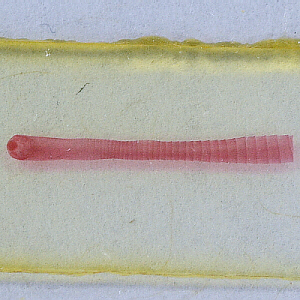
Anterior Segments of Tapeworm
 Tapeworms are another parasitic type of flatworm (Class Cestoda).
Their first segment is a “head” with suckers and hooks to attach
within their host’s intestines. Their bodies are made of a number of
subsequent segments, each of which is pretty much on its own and
separate from the rest. These segments don’t need a digestive system
because they absorb food from the host’s digestive tract and don’t
need a respiratory system because they absorb dissolved air
(O2), again, from the fluids in the host’s digestive tract.
Thus, these segments are mostly reproductive system (imagine each
segment as a very prolific female!). The segments break off and are
passed out with the host’s feces. Other animals who accidentally
ingest some of the infected feces (cattle eating grass near where
other cattle have defecated) can acquire the parasite. Tapeworms can
grow very large (long) and absorb so much food from their host’s
digestive tract that they cause nutritional deficiencies.
Tapeworms are another parasitic type of flatworm (Class Cestoda).
Their first segment is a “head” with suckers and hooks to attach
within their host’s intestines. Their bodies are made of a number of
subsequent segments, each of which is pretty much on its own and
separate from the rest. These segments don’t need a digestive system
because they absorb food from the host’s digestive tract and don’t
need a respiratory system because they absorb dissolved air
(O2), again, from the fluids in the host’s digestive tract.
Thus, these segments are mostly reproductive system (imagine each
segment as a very prolific female!). The segments break off and are
passed out with the host’s feces. Other animals who accidentally
ingest some of the infected feces (cattle eating grass near where
other cattle have defecated) can acquire the parasite. Tapeworms can
grow very large (long) and absorb so much food from their host’s
digestive tract that they cause nutritional deficiencies.

Prepared Slide of Trichinella Worms
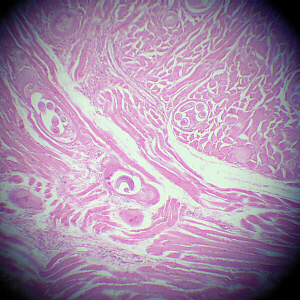
Trichinella Parasites in Muscle Tissue
- Phylum Nematoda
- (nema, nemato = a thread)
These are called roundworms because their bodies are cylindrical.
Some are free-living in aquatic habitats (including damp soil), while
others are parasitic. They have a digestive tract with openings at
both ends: a mouth and an anus, thus it is said that they have a
“tube-within-a-tube” body plan. They are bilaterally symmetrical and
do have a pseudocoelom between their mesoderm and endoderm layers.
All of their muscles are oriented longitudinally (along the worm),
only allowing for thrashing motions. They have sexual reproduction
with definite males and females.
Trichinella (trichin = a hair; -ella = small;
-osis = diseased condition or state) is the parasitic genus
whose members cause trichinosis. These parasites live in
their host’s muscles, and are often found in infected pork. Thorough
cooking at high temperatures kills the parasites, but microwaving
often does not get the center of a piece of meat hot enough for a
long enough time to be effective. Because of this, while it is OK to
reheat pork in a microwave, it should never be cooked that way
for the first time. If a person ingests living Trichinella in
undercooked meat, in the person’s intestines, the parasites will
develop from larvae into adults and reproduce. Mated females will
bore into the person’s intestinal muscles, where they will produce a
new generation of larvae. These new larvae, in turn, either travel
through the person’s lymph system or burrow through his/her body
tissue to reach his/her muscles and other tissue where they will
live.
Parasitic roundworms also include pinworm and hookworm. School
children frequently contract pinworm from doorknobs, etc. at school
because infected classmates don’t wash their hands after wiping feces
from their anal areas. Pinworms live in the rectum and lay their eggs
around the anus, thus one main sign of a pinworm infection is when a
child frequently scratches his/her anal area. A classic test for
pinworm infection is to touch a piece of scotch tape to the child’s
anal area, followed by microscopic examination of the tape to check
for the presence of pinworm eggs.
Many roundworms are free-living, but need to live in an aquatic
environment of some sort, which can include damp soil. Many soil
nematodes are beneficial and are important decomposers, but there are
some which can be found in garden soil that damage desirable
plants.
- Phylum Annelida

- (annel = a little ring, a ring)
Annelid classes include Class Oligochaeta (oligo = few,
scant; chaeta, setum = bristle), earthworms with few setae;
Class Polychaeta (poly = many), marine worms with
projections from each segment (parapods — para = beside,
near; poda = foot) which serve as gills and bear many setae;
and Class Hirudinea, leeches. Annelids are segmented, both
inside and out. They have tube-within-a-tube body plan. Earthworms
have a closed circulatory system with five pairs of “hearts.”
Annelids have a ventral, solid nervous system which arises from
mesoderm tissue (Compare this with the vertebrate nervous system which
is dorsal, hollow, and of ectodermal origin.). Many of the internal
organs, for example, the paired nephridia (nephri =
kidney) which serve an excretory function analogous to our kidneys,
are repeated in each segment. Earthworms exchange air (“breathe”)
through their moist skin, thus if a worm dries out, besides the dangers
of dehydration, it can’t get air so it dies. However, earthworms also
cannot live underwater, and if the soil in which they are living becomes
totally filled with water during a heavy rain, they will all come to
the surface so they don’t drown (and end up on the sidewalk where they
subsequently dry out after the rain stops). Earthworms are
hermaphroditic and a pair of worms fertilize each other. Annelids
have both longitudinal and circular muscles, so better control over
their movement.
(photos of earthworm anatomy)
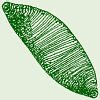 Many leeches suck blood. Some have sharp jaws to slit their host’s
skin, while others secrete an enzyme to digest a hole in the victim’s
skin. It is to the leech’s advantage if the would-be victim remains
unaware of the leech’s presence, thus most leeches secrete some kind
of anesthetic (an = not, without; aesthet =
sensitive, perception) so the host does not feel their attack. To
prevent the blood from clotting before they ingest it, leeches also
secrete an anticoagulant (anti = against, opposite;
co- = with, together; ageve = to move, put in motion;
coagulum = rennet). For years, people thought disease was
caused by too much blood, so the Medicinal Leech Hirudo
medicinalis was used to suck some out. Typically a medicinal
leech, once attached, may suck for a couple hours, perhaps ingesting
between one to two ounces of blood, many times its own body weight.
While we now have different theories as to the cause of diseases,
medicinal leeches still have uses in modern medicine! When someone
severs a finger which must be surgically reattached, since all the
capillaries are dysfunctional, blood flowing into the finger via the
reconstructed arteries has nowhere to go but into the tissue. This
leads to problems with edema in the area. Also, because of this poor
circulation, the reattached tissues cannot get the air and nutrients
they need to heal properly. It has been discovered that letting a
leech suck on the end of the reattached finger will a) help reduce
edema, and b) create a sort-of blood flow that will allow nutrients
and air to get to the reattached tissues so they heal better and more
quickly. Additionally, the anticoagulant secreted by the Medicinal
Leech is very powerful, and a leech bite (in a person whose blood
usually clots normally) can take a couple days to stop bleeding and
form a scab. Research is being done on using this powerful
anticoagulant to help heart attack and stroke victims whose problems
are caused by blood clots.
Many leeches suck blood. Some have sharp jaws to slit their host’s
skin, while others secrete an enzyme to digest a hole in the victim’s
skin. It is to the leech’s advantage if the would-be victim remains
unaware of the leech’s presence, thus most leeches secrete some kind
of anesthetic (an = not, without; aesthet =
sensitive, perception) so the host does not feel their attack. To
prevent the blood from clotting before they ingest it, leeches also
secrete an anticoagulant (anti = against, opposite;
co- = with, together; ageve = to move, put in motion;
coagulum = rennet). For years, people thought disease was
caused by too much blood, so the Medicinal Leech Hirudo
medicinalis was used to suck some out. Typically a medicinal
leech, once attached, may suck for a couple hours, perhaps ingesting
between one to two ounces of blood, many times its own body weight.
While we now have different theories as to the cause of diseases,
medicinal leeches still have uses in modern medicine! When someone
severs a finger which must be surgically reattached, since all the
capillaries are dysfunctional, blood flowing into the finger via the
reconstructed arteries has nowhere to go but into the tissue. This
leads to problems with edema in the area. Also, because of this poor
circulation, the reattached tissues cannot get the air and nutrients
they need to heal properly. It has been discovered that letting a
leech suck on the end of the reattached finger will a) help reduce
edema, and b) create a sort-of blood flow that will allow nutrients
and air to get to the reattached tissues so they heal better and more
quickly. Additionally, the anticoagulant secreted by the Medicinal
Leech is very powerful, and a leech bite (in a person whose blood
usually clots normally) can take a couple days to stop bleeding and
form a scab. Research is being done on using this powerful
anticoagulant to help heart attack and stroke victims whose problems
are caused by blood clots.
Marine worms have a pair of gill-like structures called
parapods projecting from the sides of each segment. It is
believed that the early annelid ancestors of insects (and other
arthropods) may have looked like this (and the parapods later became
modified into true legs).
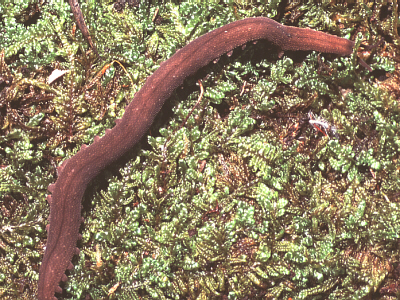
Macroperipatus torquatus from Trinidad © M. K. Busching
- Phylum Onychophora
- (onycho = a claw, nail; phora, fer = to bear,
carry)
Many biologists feel that, evolutionarily, this phylum is midway
between Annelida and Arthropoda. The phylum includes genera
Peripatus (peri = around, -patus = a walk, path)
and Macroperipatus (macro = large, long), called the
“walking worms.” One prevalent theory is that Onychophora is thought
to have evolved from a marine worm-type ancestor, with the parapods
evolving into unsegmented legs. This theory regards onychophorans as
a sort-of “missing link” on the way to the evolution of insects.
(Other biologists believe that arthropods arose directly from annelids
through some jointed-legged ancestor.) Onychophorans have unjointed
walking legs with claws at the tips, and antennae and jaws which both
are modified appendages like arthropods. Onychophorans are predatory
and shoot sticky, mucus/saliva to tangle their prey. They have males
and females and are live-bearing. Their excretory system consists of
segmented, paired nephridia like annelids. They also share the
presence and structure of their cuticle, their ciliated reproductive
tract, and their musculature with Phylum Annelida. However, their
respiratory system of tracheal tubes directly to the various organs,
their open circulatory system, and their chitinous exoskeleton
which must periodically be molted are shared with Phylum Arthropoda.

- Phylum Arthropoda
- (arthro = joint; poda = foot)
This phylum fits in here, but we’ll come back to it later because it
needs a longer discussion. It is thought that next step in
arthropod/insect evolution was an early arthropod that looked similar
to centipedes with one pair of appendages per segment (although
without certain other specializations seen in modern
centipedes).
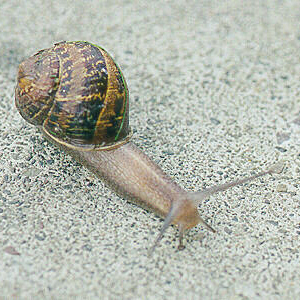
Snail
- Phylum Mollusca
- (mollusc = soft)
There are several classes of mollusks: Class Polyplacophora
(poly = many; plakos = flat plate, tablet; phora
= bear, carry) which includes the chitons, Class Gastropoda
(gastro = stomach; poda = foot) which includes snails
and slugs, Class Bivalvia or Pelecypodia (bi = two)
which includes oysters and clams, and Class Cephalopoda
(cephalo = head) which includes octopus (octa = eight),
squid, and chambered nautilus. Mollusks are soft-bodied and have a
true coelom. Many have shells made primarily of calcium carbonate:
chitons have a shell made of eight plates, snails have one, spiraled
shell, clams have a shell composed of two, hinged halves, squid have
small internal “shells,” and the chambered nautilus has a chambered
shell (spiraling in living species but straight in many fossil forms).
Snails and slugs have a radula (radul = a scraper), a
rasping organ in their mouths to “scrape” bits of food into their
mouth. Most bivalves use their gills to filter small food particles,
which are then directed toward their mouths. Cephalopods have
beaklike jaws for biting and crushing their prey, and unlike members
of the other classes, tend to be fast-moving carnivores. Many
mollusks have good eyes (snail, octopus, squid). Octopuses are famous
for their well-developed nervous systems and brains (necessary to
process the information from their sophisticated eyes), and they are
known to be very intelligent. Most mollusks have males and females,
while garden snails are hermaphroditic.
- Phylum Echinodermata
- (echino = hedgehog, sea urchin, spiny; derm =
skin)
This includes starfish and sea stars in Class Asteroidea
(aster = star), brittle stars in Class Ophiuroidea, sea
urchins and sand dollars in Class Echinoidea, sea lilies or
crinoids in Class Crinoidea, and sea cucumbers in Class
Holothuroidea (holo = whole). Echinoderms are more closely
related to chordates than any of the other invertebrate phyla. Their
larvae have bilateral symmetry, but metamorphose to adults that have
secondarily radial symmetry (have lost bilateral symmetry, rather than
never had it). They have endoskeletons (endo = within,
inner) with thin skins over them (vaguely reminiscent of our endoskeleton
with skin on the outside). Echinoderms have an unique hydraulic
system consisting of external, suction-cup-like tube feet
connected by internal “plumbing.” By pumping fluid from one part of
the hydraulic system to another, echinoderms can create a strong
suction in the tube feet, aiding in movement and feeding. They have
sexual reproduction with males and females. Much to the chagrin of
early oyster fishermen, starfish are also capable of asexual
reproduction by regeneration. Starfish prey on oysters, thus
the oyster fishermen would cut up starfish to try to kill them,
only to find the starfish population in their oyster beds had
increased because one arm can regenerate a whole new starfish.
Starfish have an unique way of feeding: they use hydraulic pressure
in their tube feet to pull open a clam or oyster, and since this
doesn’t involve the use of any muscles, the starfish doesn’t “get
tired” pulling on the clam shell. The clam, however, must use its
muscles to hold itself shut, and muscles can’t work forever without
getting fatigued, so eventually the clam’s muscles will get tired and
relax. When the clam tires and opens up, the starfish inverts its
stomach into the clam and secreted digestive enzymes to digest the
clam then and there.
- Phylum Chordata
- We will come back to this after we discuss the Arthropods.
Copyright © 1997 by J. Stein Carter. All rights reserved.
This page has been accessed  times since 18 Mar 2001.
times since 18 Mar 2001.






 Tapeworms are another parasitic type of flatworm (Class Cestoda).
Their first segment is a “head” with suckers and hooks to attach
within their host’s intestines. Their bodies are made of a number of
subsequent segments, each of which is pretty much on its own and
separate from the rest. These segments don’t need a digestive system
because they absorb food from the host’s digestive tract and don’t
need a respiratory system because they absorb dissolved air
(O2), again, from the fluids in the host’s digestive tract.
Thus, these segments are mostly reproductive system (imagine each
segment as a very prolific female!). The segments break off and are
passed out with the host’s feces. Other animals who accidentally
ingest some of the infected feces (cattle eating grass near where
other cattle have defecated) can acquire the parasite. Tapeworms can
grow very large (long) and absorb so much food from their host’s
digestive tract that they cause nutritional deficiencies.
Tapeworms are another parasitic type of flatworm (Class Cestoda).
Their first segment is a “head” with suckers and hooks to attach
within their host’s intestines. Their bodies are made of a number of
subsequent segments, each of which is pretty much on its own and
separate from the rest. These segments don’t need a digestive system
because they absorb food from the host’s digestive tract and don’t
need a respiratory system because they absorb dissolved air
(O2), again, from the fluids in the host’s digestive tract.
Thus, these segments are mostly reproductive system (imagine each
segment as a very prolific female!). The segments break off and are
passed out with the host’s feces. Other animals who accidentally
ingest some of the infected feces (cattle eating grass near where
other cattle have defecated) can acquire the parasite. Tapeworms can
grow very large (long) and absorb so much food from their host’s
digestive tract that they cause nutritional deficiencies.



 Many leeches suck blood. Some have sharp jaws to slit their host’s
skin, while others secrete an enzyme to digest a hole in the victim’s
skin. It is to the leech’s advantage if the would-be victim remains
unaware of the leech’s presence, thus most leeches secrete some kind
of anesthetic (an = not, without; aesthet =
sensitive, perception) so the host does not feel their attack. To
prevent the blood from clotting before they ingest it, leeches also
secrete an anticoagulant (anti = against, opposite;
co- = with, together; ageve = to move, put in motion;
coagulum = rennet). For years, people thought disease was
caused by too much blood, so the Medicinal Leech Hirudo
medicinalis was used to suck some out. Typically a medicinal
leech, once attached, may suck for a couple hours, perhaps ingesting
between one to two ounces of blood, many times its own body weight.
While we now have different theories as to the cause of diseases,
medicinal leeches still have uses in modern medicine! When someone
severs a finger which must be surgically reattached, since all the
capillaries are dysfunctional, blood flowing into the finger via the
reconstructed arteries has nowhere to go but into the tissue. This
leads to problems with edema in the area. Also, because of this poor
circulation, the reattached tissues cannot get the air and nutrients
they need to heal properly. It has been discovered that letting a
leech suck on the end of the reattached finger will a) help reduce
edema, and b) create a sort-of blood flow that will allow nutrients
and air to get to the reattached tissues so they heal better and more
quickly. Additionally, the anticoagulant secreted by the Medicinal
Leech is very powerful, and a leech bite (in a person whose blood
usually clots normally) can take a couple days to stop bleeding and
form a scab. Research is being done on using this powerful
anticoagulant to help heart attack and stroke victims whose problems
are caused by blood clots.
Many leeches suck blood. Some have sharp jaws to slit their host’s
skin, while others secrete an enzyme to digest a hole in the victim’s
skin. It is to the leech’s advantage if the would-be victim remains
unaware of the leech’s presence, thus most leeches secrete some kind
of anesthetic (an = not, without; aesthet =
sensitive, perception) so the host does not feel their attack. To
prevent the blood from clotting before they ingest it, leeches also
secrete an anticoagulant (anti = against, opposite;
co- = with, together; ageve = to move, put in motion;
coagulum = rennet). For years, people thought disease was
caused by too much blood, so the Medicinal Leech Hirudo
medicinalis was used to suck some out. Typically a medicinal
leech, once attached, may suck for a couple hours, perhaps ingesting
between one to two ounces of blood, many times its own body weight.
While we now have different theories as to the cause of diseases,
medicinal leeches still have uses in modern medicine! When someone
severs a finger which must be surgically reattached, since all the
capillaries are dysfunctional, blood flowing into the finger via the
reconstructed arteries has nowhere to go but into the tissue. This
leads to problems with edema in the area. Also, because of this poor
circulation, the reattached tissues cannot get the air and nutrients
they need to heal properly. It has been discovered that letting a
leech suck on the end of the reattached finger will a) help reduce
edema, and b) create a sort-of blood flow that will allow nutrients
and air to get to the reattached tissues so they heal better and more
quickly. Additionally, the anticoagulant secreted by the Medicinal
Leech is very powerful, and a leech bite (in a person whose blood
usually clots normally) can take a couple days to stop bleeding and
form a scab. Research is being done on using this powerful
anticoagulant to help heart attack and stroke victims whose problems
are caused by blood clots. 

